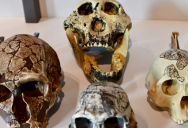Jawbone Found Of 4.3 Million-Year-Old Hominin That Likely Walked The Earth With Our Early Ancestors

When many people think of the evolution of humans, they think of a line that goes back throughout all of our ancestors.
This is largely because the common pictures out there show just the major points where modern scientists have set major advancements along the way.
While those pictures are accurate to show certain types of data, they can also be misleading. Historically, there were many different lines of human ancestors that broke off but did not survive to today.
In addition, there were various hominin species that lived simultaneously.
Archaeologists in Kenya have found a jawbone that is showing just that.
The jawbone belongs to someone from the species Australopithecus anamensis, which was an ape-like creature. Interestingly, analysis shows that this ancient ancestor likely walked the Earth at the same time as some of our earliest ancestors.
They may have competed for resources, with our direct ancestors becoming dominant.

The species that this jawbone comes from is dated back to about 4.2 million years ago.
The authors of the study, which was published in the Journal of Human Evolution, wrote:
“Though the new specimen is only [100,000 years] older than the existing Au. anamensis samples from [Kenya and Ethiopia], the extension of this species’ [earliest appearance] […] shows that the earliest australopiths temporally overlapped with late-surviving basal hominins in the Early Pliocene.”

Learning more about our ancient ancestors, and the other similar creatures that lived at the same time, can help to teach us a lot about how evolution works and the many factors that influence the path we took to where we are today.
The more we can learn about our past, the better we understand our present and future.
Thought that was fascinating? Here’s another story you might like: Why You’ll Never See A Great White Shark In An Aquarium

Sign up to get our BEST stories of the week straight to your inbox.




